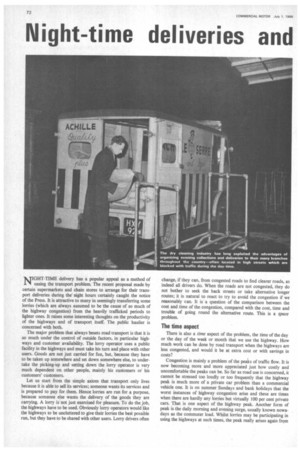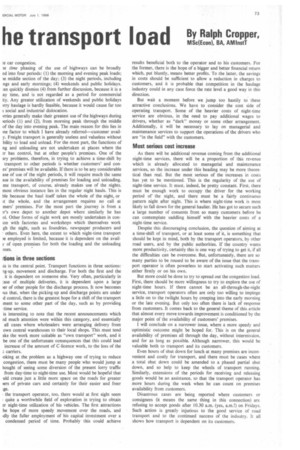Night-time deliveries and he transport load
Page 74

Page 75

If you've noticed an error in this article please click here to report it so we can fix it.
By Ralph Cropper,
MSc(Econ), BA, AMInstT
NGHT-TIME delivery has a popular appeal as a method of easing the transport problem. The recent proposal made by certain supermarkets and chain stores to arrange for their transport deliveries during the night hours certainly caught the notice of the Press. It is attractive to many in seemingly transferring some lorries (which are always assumed to be the cause of so much of the highway congestion) from the heavily trafficked periods to lighter ones. It raises some interesting thoughts on the productivity of the highways and of transport itself. The public haulier is concerned with both.
The major problem that always besets road transport is that it is so much under the control of outside factors, in particular highways and customer availability. The lorry operator uses a public facility in the highways and must take his turn and place with other users. Goods are not just carried for fun, but, because they have to be taken up somewhere and set down somewhere else, to undertake the picking-up and setting down the lorry operator is very much dependent on other people, mainly his customers or his customers' customers.
Let us start from the simple axiom that transport only lives because it is able to sell its services; someone wants its services and is prepared to pay for them. Hence lorries are run for a purpose. because someone else wants the delivery of the goods they are carrying. A lorry is not just exercised for pleasure. To do the job, the highways have to be used. Obviously lorry operators would like the highways to be uncluttered to give their lorries the best possible run, but they have to be shared with other users. Lorry drivers often
change, if they can, from congested roads to find clearer roads, as indeed all drivers do. When the roads are not congested, they do not bother to seek the back streets or take alternative longer routes; it is natural to react to try to avoid the congestion if we reasonably can. It is a question of the comparison between the cost and time of the congestion, compared with the cost, time and trouble of going round the alternative route. This is a space problem.
The time aspect
There is also a time aspect of the problem. the time of the day or the day of the week or month that we use the highway. How much work can be done by road transport when the highways are less congested, and would it be at extra cost or with savings in costs?
Congestion is mainly a problem of the peaks of traffic flow. It is now becoming more and more appreciated just how costly and uncomfortable the peaks can be. So far as road use is concerned, it cannot be stressed too loudly or too frequently that the highway peak is much more of a private car problem than a commercial vehicle one. It is on summer Sundays and bank holidays that the worst instances of highway congestion arise and these are times when there are hardly any lorries but virtually 100 per cent private cars. That is one aspect of the highway peak. Another form of peak is the daily morning and evening surge, usually known nowadays as the commuter load. Whilst lorries may be participating in using the highways at such times, the peak really arises again from te car congestion.
ie time phasing of the use of highways can be broadly ed into four periods: (1) the morning and evening peak loads; re middle section of the day; (3) the night periods, including ngs and early mornings; (4) weekends and public holidays. an quickly dismiss (4) from further discussion, because it is a ay time, and is not regarded as a period for commercial ity. Any greater utilization of weekends and public holidays wry haulage is hardly feasible, because it would cause far too social and industrial dislocation.
rries generally make their greatest use of the highways during ieriods (1) and (2), from morning peak through the middle of the day into evening peak. The main reason for this lies in ■ ne factor to which I have already referred—customer alley. Freight transport is generally useless and valueless without bility to load and unload. For the most part, the functions of ng and unloading are not undertaken at places where the sr has control, but at other people's premises. One of the try problems, therefore, in trying to achieve a time-shift by transport to other periods is whether customers' and cones' premises will be available. If there is to be any considerable ase of use of the night periods, it will require much the same ase in the availability of premises for loading and unloading. me transport, of course, already makes use of the nights. most obvious instance lies in the regular night hauls. This is ble ,because the haul itself takes the whole of the night, or it the whole, and the arrangement requires no call at mers' premises. For the most part the journey is from a :r's own depot to another depot where similarly he has ol. Other forms of night work are mostly undertaken in conon with factories and workshops which themselves work gh the night, such as foundries, newspaper producers and others. Even here, the extent to which night-time transport >e employed is limited, because it is dependent on the availy of open premises for both the loading and the unloading uses.
lions in three sections
kis is the central point. Transport functions in three sections: ig-up, movement and discharge. For both the first and the it is dependent on someone else. Very often, particularly in ase of multiple deliveries, it is dependent upon a large ier of other people for the discharge process. It now becomes 'us that, when the picking-up and discharge points are under d control, there is the greatest hope for a shift of the transport ment to some other part of the day, such as by providing -time service.
is interesting to note that the recent announcements which ed much attention were within this category, and essentially all cases where wholesalers were arranging delivery from own central warehouses to their local shops. This must tend ake the work more suitable as "own transport" work, and it be one of the unfortunate consequences that this could lead increase of the amount of C-licence work, to the loss of the ; carriers.
.oking at the problem as a highway one of trying to reduce congestion, there must be many people who would jump at bought of seeing some diversion of the present lorry traffic from day-time to night-time use. Most would be hopeful that uld create just a little more space on the roads for greater iers of private cars and certainly for their easier and freer the transport operator, too, there would at first sight seem quite a worthwhile field of exploration in trying to obtain er night-time utilization of his vehicles. The first attractions he hope of more speedy movement over the roads, and Ally the fuller employment of his capital investment over a condensed period of time. Probably this could achieve results beneficial both to the operator and to his customers. For the former, there is the hope of a bigger and better financial return which, put bluntly, means better profits. To the latter, the savings in costs should be sufficient to allow a reduction in charges to customers, and it is probable that competition in the haulage industry could in any case force the rate level a good way in this direction.
But wait a moment before we jump too hastily to these attractive conclusions. We have to consider the cost side of operating transport. Some of the heavier costs of night-time service are obvious, in the need to pay additional wages to drivers, whether as "dark" money or some other arrangement. Additionally, it will be necessary to lay on managerial and maintenance services to support the operations of the drivers who are "in the field" with the customers.
Most serious cost increase
As there will be additional revenue coming from the additional night-time services, there will be a proportion of this revenue which is already allocated to managerial and maintenance services, so the increase under this heading may be more theoretical than real. But the most serious of the increases in costs has yet to be mentioned. This is the regularity of the use of night-time service. It must, indeed, be pretty constant. First, there must be enough work to occupy the driver for the working period or the night, and there must be a fairly continuous pattern night after night. This is where night-time work is most likely to fall down for the general haulier. He has got to secure such a large number of consents from so many customers before he can contemplate saddling himself with the heavier costs of a night-time service.
Despite this discouraging conclusion, the question of aiming at a time-shift of transport, or at least some of it, is something that should be kept in mind, both by the transport operators, by other road users, and by the public authorities. If the country wants more productivity, certainly this is one way of trying to get it, if all the difficulties can be overcome. But, unfortunately, there are so many parties to be roused to be aware of the issue that the transport operator is often powerless to start activating such matters either firstly or on his own.
But more could be done to try to spread out the congestion load. First, there should be more willingness to try to explore the use of night-time hours. If there cannot be an all-through-the-night service, transport operators often are only too willing to impinge a little on to the twilight hours by creeping into the early morning or the late evening. But only too often there is lack of response from customers. It comes back to the general theme of this. article that almost every move towards improvement is conditioned by the major point of the availability of customers' premises.
I will conclude on a narrower issue, where a more speedy and optimistic outcome might be hoped for. This is on the general availability of premises all through the day, without intermission, and for as long as possible. Although narrower, this would be valuable both to transport and its customers.
Even hours of shut down for lunch at many premises are inconvenient and costly for transport, and there must be cases where a total shut down could be amended to a phased partial shut down, and so help to keep the wheels of transport running. Similarly, extensions of the periods for receiving and releasing goods would be an assistance, so that the transport operator has more hours during the week when he can count on premises availability from customers.
Disastrous cases are being reported where customers or consignees (it means the same thing in this connection) are refusing to accept goods after 10.30 a.m. (yes, a.m.!) on Fridays. Such action is greatly injurious to the good service of road transport and to the continued success of the industry. It all shows how transport is dependent on its customers.




























































































































